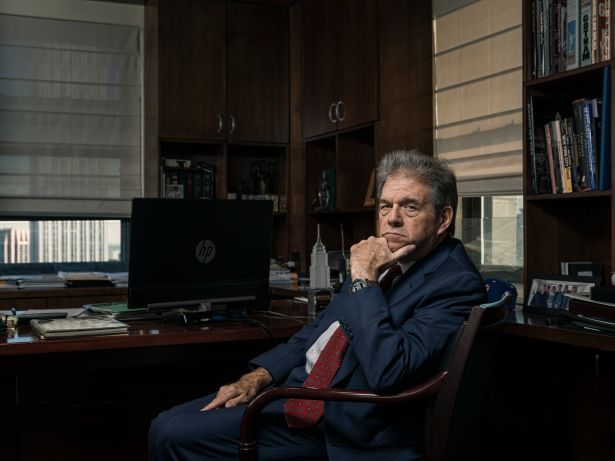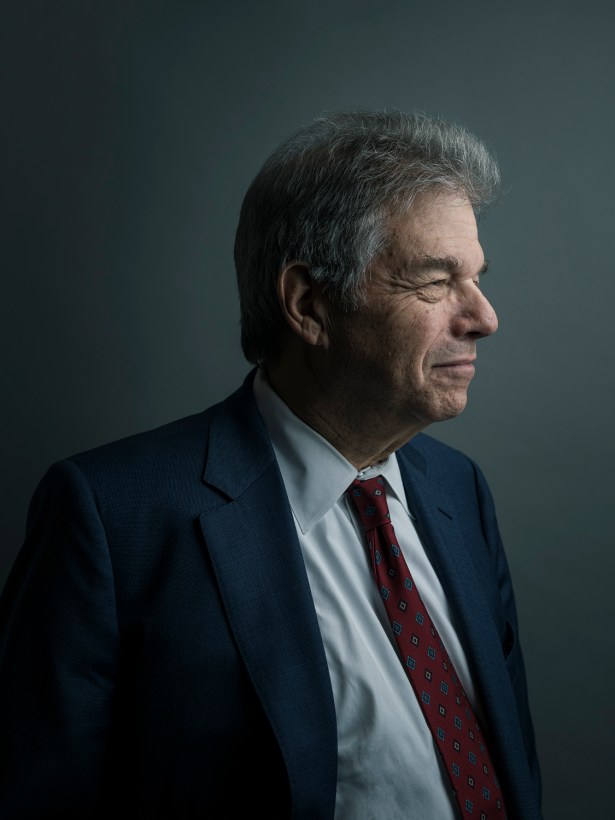Steven Kaufman Discusses the Garment District, the Ring Portfolio and Trump
By Cathy Cunningham November 17, 2016 12:43 pm
reprints
Steven Kaufman’s entrée into the real estate industry began long before he was born—it started with his grandfather, Samuel Kaufman, who started Kaufman Organization in 1918, snatching up and developing office and retail properties over the years. By the time his grandson joined the family business in 1973 at the age of 25, there was no shortage of real estate to manage. The elder Kaufman had a particular affinity for the Garment District, a love that clearly has been passed down through the generations.
Commercial Observer met with Steven Kaufman at his office at 450 Seventh Avenue between West 34th and West 35th Streets on Nov. 8 (a.k.a., Election Day). We couldn’t begin the interview without addressing the 500-pound gorilla in the room.
Commercial Observer: Have you voted already?
Kaufman: Yes. I live on the Upper West Side of Manhattan, which is a really liberal neighborhood. I was moved by the number of people voting this morning. I waited on line for 45 minutes, but my wife waited one hour and 45 minutes. I love Election Day; I love to see democracy in action.
What might the country look like tomorrow, when the votes are counted?
If Hillary wins, and I think she will, there will be a huge sigh of relief because I think that Donald Trump is a very dangerous, disruptive influence on the country and would be a really negative choice as president. For a country that elected Barack Obama four years ago—with, what, 53 percent of the vote?—[the idea] that a person like Donald Trump could get the amount of support that he has is just incredible.
What would it mean for financial markets if Trump won?
I think it would be terrible for the financial markets. I was talking to a fellow in real estate this morning, and he said, “If you have a manufacturing company and you’re importing from China or Mexico, you don’t know what’s going to happen.” It could really spell a tremendous amount of uncertainty for many businesses.
I’ve been in this business over 40 years, and I remember when these buildings in the Garment District, where we are sitting, were mostly factories. Now, will we go back to garment factories along West 35th Street and Eighth Avenue? I don’t think so.
At one point, in the 1940s and 1950s, around 95 percent of the garments sold in this country were also made in this country. In fact, I think most of them were made right here in New York City. Now, it’s around 5 percent. So when Donald Trump talks about bringing manufacturing jobs back to this country, it’s nonsensical. Whether it’s manufacturing garments or automobiles or mining coal in West Virginia, it’s not coming back. It’s done. And most people don’t want it to come back.
In your mind, how does this U.S. presidential election compare to the U.K.’s Brexit vote?
Brexit was a real surprise, but Scotland voted against it and may want its independence. We haven’t had a state secede since the Civil War, and that didn’t work out very well. There was actually a movement in the 1960s to make New York City the 51st state. Norman Mailer and Jimmy Breslin ran for mayor and senator, [respectively]. At that point, New York City was viewed as being so different from the rest of the country. It was when Nixon was president—I was a young guy at the time. And there was talk that New York City should be a separate state, but now we’re on better terms with the rest of the state.
Your grandfather started the Kaufman Organization. What was it like growing up in a multigenerational real estate family?
Well, I actually didn’t know my grandfather—he died when I was a baby—but my father and my uncle were in the business [as partners in Kaufman Organization]. It was a very different business back then. It wasn’t that big of a deal to own Manhattan real estate, particularly on the West Side over here [near Kaufman’s office at 450 Seventh Avenue]. I never thought of myself as an heir to a real estate fortune, because I wasn’t. I’m still not. The ownership is split up among many different people—we own [buildings] with partners. In some other families, like the Dursts or the Rudins, the ownership is very concentrated. The Kaufmans? Not so much. There are other families involved with us.
You must have seen multiple market cycles during your four decades in the industry.
I have. When I came into the business, it was horrible. There were so many vacancies. It was when New York City almost went bankrupt in 1975. There was a famous headline in the New York Daily News, “Ford to City: Drop Dead.” It was really a rough time, and there weren’t any tenants around to rent space to. I used to kid around with my uncle Ben when we had the chance of renting space to a tenant, he’d say, “Lock them in the room until they sign the lease!”
But, it was also a time of great opportunity—if you had some foresight and some guts you could buy real estate really cheap. My cousin George [Kaufman, the chairman of Kaufman Organization,] was one of those people who had that foresight. He bought real estate and did extremely well with it.
So, given those circumstances, what appealed to you about the business back then?
Well, I wanted to try it. It looked interesting to me at the time. I have an interest in the architecture of buildings, of cities and of the urban landscape. It’s worked out really well for me, and I’m very happy that I did it. In this business, as in any business, the more you do it, the better you get at it. You have a sense of confidence and a sense of accomplishment.
What has been the best cycle in your opinion?
The last seven to eight years have been fantastic. Since the recession [in 2008], seeing some of these buildings that we have owned for many years, in Chelsea and the Flatiron District, turnaround from being factory buildings to high-class office spaces has been amazing. And the opportunities we’ve had to buy new buildings like the Madison Square Portfolio [formerly the Ring portfolio] and take derelict, broken-down properties and restore them and rent them—that has really been a great experience.

I assume that attracting tenants is easier today than it was in the 1970s.
It’s become a lot easier, for sure. Commercial Observer didn’t exist back then because the business wasn’t as interesting as it is today. Had it existed, you would not have been interested in Kaufman. We were not that interesting in the 1970s, 1980s or even 1990s.
What was it like coming into an industry and managing buildings in a not-so-great New York City?
It was a good experience because it taught me that things aren’t always going to be good and you have to be prepared for economic ups and downs. I remember negotiating over nickels per square foot, and some of our buildings distributed no money to their owners back then. They were making no money—they could barely pay the real estate taxes.
You had to have a thick skin, I’d imagine?
Yes. The city was dangerous. We had buildings on the side streets of the Garment Center on Eighth Avenue that nobody wanted to go near. Times Square was no bargain either! But that was my initiation to the real estate business. I was always a city guy. I raised my family here. It’s great to see New York—I don’t want to say ‘come back’—but it’s different than it ever was.
Midtown South properties make up a large part of your portfolio. Why do you like that area of Manhattan?
We like the Chelsea and Garment District areas very much and are always looking to expand. It’s convenient to transportation and the buildings themselves are good buildings to be in—they’re desirable. The infrastructure of the local restaurants and shopping has gotten much, much better recently. And people want to work there today.
This is our flagship building [450 Seventh Avenue], which we have owned for several years, and being on the corner of 34th Street and Seventh Avenue—there’s always a demand for space. It’s across from Penn Station and every subway stops here. Some of the buildings that we recently acquired on 27th Street and 24th Street weren’t desirable [in the past]. People were afraid to walk on these side streets. They were dark. They were dingy. There were no restaurants. There were no stores. But, now it’s [much better].
It’s nice that you’re still heavily focused on the Garment District, seeing as this is where your grandfather started the business.
Yes, we still have a critical mass of buildings in the Garment District. It’s the area I probably know better than any in the city.
You’ve enticed some fashion houses such as Catherine Malandrino, Sachin & Babi, Carmen Marc Valvo and Donna Morgan away from the avenues and into side-street properties over the years. Why are side streets on the up and up?
The side streets are becoming safer. They used to not feel safe and actually weren’t safe. I’m on the board for the Garment District Alliance, and one of the really successful programs we had was the lighting of the side streets. Crime is practically nonexistent today. Amazingly, the side streets in the Garment District have become, in a sense, more desirable than the avenues, particularly for some of the fashion companies and technology, advertising, media and information companies. They like the vibe of it because you’re away from Seventh Avenue, which is so busy that you can’t walk on it sometimes. The side streets have a better feel to them.
Do you see the other core office markets in Manhattan suffering as new development springs up around Hudson Yards in terms of say, lower rents?
I don’t see suffering from that so much, but I think what has happened is that rents in the more traditional office centers—like Third Avenue, Sixth Avenue or Park Avenue uptown—are somewhat depressed because a lot of companies now prefer to be in older loft buildings. So Downtown in Chelsea, Flatiron, Soho, Hudson Square—all the areas with older buildings—have been converted and upgraded. A lot of companies prefer to be in those locations because they’re a little different with a little more of a hip and younger vibe.
Let’s talk about the Madison Square Portfolio. How did the deal to net lease four of the buildings from Extell Development [in April 2014 and paying between $175 and $200 million, depending on valuation] come about, and what’s the latest?
Well, it came about because Gary Barnett [the founder and president of Extell] was able to acquire all 14 of the Ring buildings. There were two brothers, Frank and Michael Ring, who inherited the buildings from their father, Leo. For reasons no one quite understands, they let those 14 commercial buildings fall into significant states of disrepair. In some cases they were totally empty. They were just paying taxes on them.
So, every real estate person in New York knew about these buildings. A lot of people tried to get them, and we did too. I knew the Ring brothers, and we had spoken over the years, but nothing came of it. But Gary Barnett was able to get control of the whole portfolio. He sold off some of them, or net leased them, and we got 13-15 West 27th Street, 45 West 27th Street, 19 West 24th Street and 119-125 West 24th Street on 99-year net leases.
One-nineteen West 24th Street was empty but in pretty good shape, and so we were able to rent pretty quickly to Anheuser-Busch, the beer company, who took most of the building. And a coworking space company called Alley took four floors. That building is fully rented now.
The other three were smaller buildings, all empty also. We’ve pretty much fully rented 19 West 24th Street; 13 West 27th Street is renting very quickly, and we just hit the market with 45 West 27th Street. We also got another property at 155 West 23rd Street from Barnett. That was also 99-year net lease, but we’re not quite ready to put that one on the market. These buildings had no working elevators, they had no heat. They needed a lot of work. It took a couple of years to get them in shape.
You partnered with China Orient Asset Management, who bought a majority stake in the buildings. How did this relationship come about?
Our acquisitions team, Fredric Leffel and Michael Kazmierski, evolved that relationship. A lot of networking is required, and our acquisitions team is very good at that. They know who to call.
What’s in your pipeline for the rest of the year?
We’re working on some acquisitions in Manhattan. I have three situations in the fire right now in Chelsea and Flatiron; hopefully they’ll cook. They may even close before the end of the year.
Then, the leasing part of my business is always active. I have 75,000 square feet at 111 West 19th Street, one of our core buildings that we’ve owned for many years, that I’m trying to rent right now.
My internal leasing team went through an upheaval recently because my key person, a woman by the name of Barbara Raskob, passed away [on Oct. 15 following a brief illness]. That was very rough for us. She was my right hand in many ways—we worked together for 19 years. We had to reshuffle things here, and I have two very good people who have taken Barbara’s place—Yvonne Chang and Sam Stein. It’s been a lot of work for the three of us.
You obviously place great value on your team.
My team is everything. I mentioned Fred and Michael, then there’s Grant Greenspan [the principal of Kaufman Leasing Company] and Michael Giglio [Kaufman Organization’s chief financial officer], who are instrumental in our business.

Given your experience, what piece of advice would you give to someone starting out in the industry today?
Find a good company to work for, unless you’re very entrepreneurial, and you can do it by yourself. Most people don’t have that character though—so find some good people to get involved with.
You said in CO’s Owner’s Magazine that if you weren’t in real estate you would be Bruce Springsteen. Still feel the same way?
Sounds like a plan, right?


